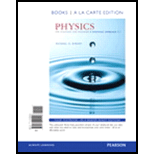
Concept explainers
Are the objects described here in equilibrium while at rest, in equilibrium while in motion, or not in equilibrium at all? Explain.
- A 200 pound barbell is held over your head.
- A girder is lifted at constant speed by a crane.
- A girder is being lowered into place. It is slowing down.
- A jet plane has reached its cruising speed and altitude.
- A box in the back of a truck doesn’t slide as the truck stops.
The objects given are in equilibrium or not.
Explanation of Solution
Given Info:
a. A person is holding a 200 pound barbell.
b. A girder is lifted at constant speed by a crane.
c. A girder is lowered into a place. It is slowing down.
d. A jet plane has reached its cruising speed and is at a high attitude.
e. A box in the back of a truck doesn't slide as the truck stops.
a. Static Equilibrium
The barbell is static, and the velocity is also zero as it is at rest.
b. Dynamic Equilibrium
There is no acceleration, but the girder has a constant velocity.
c. Not in equilibrium
As it is slowing down, it means the acceleration has a direction opposite to the direction of motion.
d. Dynamic equilibrium
There is no acceleration, but the plane has a constant velocity.
e. Not in equilibrium
The box slows down as it has negative acceleration or retardation.
Conclusion:
From the above explanation, a, b and d are in equilibrium while c and e are not.
Want to see more full solutions like this?
Chapter 6 Solutions
Physics for Scientists and Engineers: A Strategic Approach with Modern Physics, Books a la Carte Edition; Student Workbook for Physics for Scientists ... eText -- ValuePack Access Card (4th Edition)
Additional Science Textbook Solutions
Biochemistry: Concepts and Connections (2nd Edition)
Human Biology: Concepts and Current Issues (8th Edition)
Cosmic Perspective Fundamentals
Microbiology: An Introduction
Chemistry (7th Edition)
Microbiology with Diseases by Body System (5th Edition)
- 19. Mount Everest, Earth's highest mountain above sea level, has a peak of 8849 m above sea level. Assume that sea level defines the height of Earth's surface. (re = 6.38 × 106 m, ME = 5.98 × 1024 kg, G = 6.67 × 10 -11 Nm²/kg²) a. Calculate the strength of Earth's gravitational field at a point at the peak of Mount Everest. b. What is the ratio of the strength of Earth's gravitational field at a point 644416m below the surface of the Earth to a point at the top of Mount Everest? C. A tourist watching the sunrise on top of Mount Everest observes a satellite orbiting Earth at an altitude 3580 km above his position. Determine the speed of the satellite.arrow_forwardpls help on allarrow_forwardpls help on allarrow_forward
- 6. As the distance between two charges decreases, the magnitude of the electric potential energy of the two-charge system: a) Always increases b) Always decreases c) Increases if the charges have the same sign, decreases if they have the opposite signs d) Increases if the charges have the opposite sign, decreases if they have the same sign 7. To analyze the motion of an elastic collision between two charged particles we use conservation of & a) Energy, Velocity b) Momentum, Force c) Mass, Momentum d) Energy, Momentum e) Kinetic Energy, Potential Energyarrow_forwardpls help on all asked questions kindlyarrow_forwardpls help on all asked questions kindlyarrow_forward
- 17. Two charges, one of charge +2.5 × 10-5 C and the other of charge +3.7 × 10-6 C, are 25.0 cm apart. The +2.5 × 10−5 C charge is to the left of the +3.7 × 10−6 C charge. a. Draw a diagram showing the point charges and label a point Y that is 20.0 cm to the left of the +3.7 × 10-6 C charge, on the line connecting the charges. (Field lines do not need to be drawn.) b. Calculate the net electric field at point Y.arrow_forward3arrow_forwardSet ба ||Axl 49.32 6b 71 Ay 22 Magnitude of A Angle of A 24.04 Angle of -A 22 54 155.96 ° (pos Ax) 204.04 ° (neg Ax) 335.96 ° (pos Ax) ° (neg Ax) 115.77 ° (pos Ax) 295.77 ° (pos Ax) -39 81 208.78 ° (neg Ax) 28.78 ° (neg Ax)arrow_forward
 Physics for Scientists and Engineers, Technology ...PhysicsISBN:9781305116399Author:Raymond A. Serway, John W. JewettPublisher:Cengage Learning
Physics for Scientists and Engineers, Technology ...PhysicsISBN:9781305116399Author:Raymond A. Serway, John W. JewettPublisher:Cengage Learning Physics for Scientists and Engineers: Foundations...PhysicsISBN:9781133939146Author:Katz, Debora M.Publisher:Cengage Learning
Physics for Scientists and Engineers: Foundations...PhysicsISBN:9781133939146Author:Katz, Debora M.Publisher:Cengage Learning Principles of Physics: A Calculus-Based TextPhysicsISBN:9781133104261Author:Raymond A. Serway, John W. JewettPublisher:Cengage Learning
Principles of Physics: A Calculus-Based TextPhysicsISBN:9781133104261Author:Raymond A. Serway, John W. JewettPublisher:Cengage Learning Physics for Scientists and Engineers with Modern ...PhysicsISBN:9781337553292Author:Raymond A. Serway, John W. JewettPublisher:Cengage Learning
Physics for Scientists and Engineers with Modern ...PhysicsISBN:9781337553292Author:Raymond A. Serway, John W. JewettPublisher:Cengage Learning Physics for Scientists and EngineersPhysicsISBN:9781337553278Author:Raymond A. Serway, John W. JewettPublisher:Cengage Learning
Physics for Scientists and EngineersPhysicsISBN:9781337553278Author:Raymond A. Serway, John W. JewettPublisher:Cengage Learning College PhysicsPhysicsISBN:9781305952300Author:Raymond A. Serway, Chris VuillePublisher:Cengage Learning
College PhysicsPhysicsISBN:9781305952300Author:Raymond A. Serway, Chris VuillePublisher:Cengage Learning





